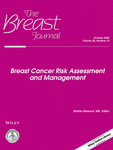One-step nucleic acid amplification CK19 copy number for sentinel node biopsy in breast cancer: Identification of new cutoffs to predict nonsentinel axillary node involvement
Abstract
We evaluated novel sentinel node values in breast cancer for one-step nucleic acid amplification (OSNA) to predict further nodal involvement using various methods in clinically node-negative disease with a positive OSNA result and subsequent axillary node dissection. 239 patients (118 macrometastatic) were assessed revealing cutoffs of total tumor load (TTL) 44 500 copies/µL (AUROC 0.793); average copy number (ACN) 9450 (AUROC 0.790); and highest copy number (HCN) 46,000. For macrometastatic patients only: TTL 221 400 copies/µL (AUROC 0.685); ACN 64,000 (AUROC 0.671); HCN 59 500 (AUROC 0.529). Our data favor TTL and represent one of the largest OSNA macrometastatic predictive series.




